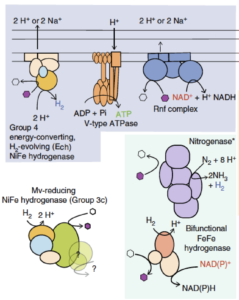
Key components of energy metabolism in Riflemargulisbacteria including different kinds of hydrogenases, a nitrogenase, and other protein complexes involved in energy conservation. Modified from the original publication (above).
Bacteria from multiple phyla related to Cyanobacteria were genomically described using metagenomics and single cell genomics, and genes were predicted for all genomes. Metabolic capacities, some featuring novel complexes, were predicted using genome-based analyses. Capacities were mapped across lineages to detect environment- and lineage-specific lifestyles.
The results suggest that the common ancestor of all of the phyla investigated may have been an anaerobe in which fermentation and H2 metabolism were central metabolic features. Capacities of phylogenetic neighbors to Cyanobacteria (the group in which oxygenic photosynthesis arose), such as Margulisbacteria, Saganbacteria, Melainabacteria and Sericytochromatia, constrain the metabolic platform in which aerobic respiration arose. The evolution of aerobic respiration was likely linked to the origins of oxygenic Cyanobacteria.
Summary
Margulisbacteria (RBX-1 and ZB3), Saganbacteria (WOR-1), Melainabacteria, and Sericytochromatia, close phylogenetic neighbors to Cyanobacteria, may constrain the metabolic platform in which aerobic respiration arose. In this study, the authors predict that sediment-associated Margulisbacteria have a fermentation-based metabolism featuring a variety of hydrogenases, a streamlined nitrogenase, and electron bifurcating complexes involved in cycling of reducing equivalents. The genomes of ocean-associated Margulisbacteria encode an electron transport chain that may support aerobic growth. Some Saganbacteria genomes encode various hydrogenases, and others may have the ability to use O2 under certain conditions via a putative novel type of heme copper O2 reductase. Similarly, Melainabacteria have diverse energy metabolisms and are capable of fermentation and aerobic or anaerobic respiration. The ancestor of all of these groups may have been an anaerobe in which fermentation and H2 metabolism were central metabolic features. The ability to use O2 as a terminal electron acceptor must have been subsequently acquired by these lineages.
Citation
P. B. Matheus Carnevali, F. Schulz, C. J. Castelle, R. S. Kantor, P. M. Shih, I. Sharon, J. M. Santini, M.R. Olm, Y. Amano, B.C. Thomas, K. Anantharaman, D. Burnstein, E. D. Becraft, R. Stepanauskas, T. Woyke, and J. F. Banfield, “Hydrogen-based metabolism as an ancestral trait in lineages sibling to the Cyanobacteria”. Nature Communications, 10, 463 (2019), doi: 10.1038/s41467-018-08246-y
